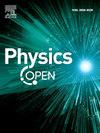陀螺域超混沌实现的光学音频密码系统
Q2 Physics and Astronomy
引用次数: 0
摘要
一些已报道的音频加密方法效率低下,抗差分攻击能力不强,在奇异混沌系统中使用伪随机数发生器会降低安全性,并逐渐暴露出其他问题。本文提出了一种基于回旋器(GT)变换和超混沌系统的新型光学音频加密系统。所提出的算法将混沌理论与传统加密技术相结合,创造出一种更符合数字音频特性的光学加密算法。为了提高安全性,超混沌系统会在破坏过程中产生各种超混沌状态。随后,随机模式分解(RMD)被用来生成两个非对称独立矢量,从而获取密文和私钥。在解密阶段,密文和私人密钥被转移到 GT 变换的输入平面。事实上,建议的加密系统适用于验证信息,因为超混沌数据对加密和解密技术至关重要。一系列攻击实验证明了该密码系统的功效和能力。本文章由计算机程序翻译,如有差异,请以英文原文为准。
Optical audio cryptosystem using hyperchaotic implementation in Gyrator domain
Some reported audio encryption methods are inefficient, their anti-differential attack capabilities are subpar, and using a pseudo-random number generator in a singular chaotic system results in diminished security, gradually revealing additional issues. This paper proposes a novel optical audio cryptosystem based on the Gyrator (GT) transform and a hyperchaotic system. The proposed algorithm involves merging chaos theory with conventional cryptographic techniques to create an optical encryption algorithm that aligns better with the properties of digital audio. To enhance security, the hyperchaotic system generates various hyperchaotic states involved in the disruption process. Subsequently, Random Mode Decomposition (RMD) is employed to generate two asymmetric independent vectors, leading to the acquisition of the ciphertext and private key. During the decryption phase, the ciphertext and private key are transferred into the input plane of the GT transform. Indeed, the suggested cryptographic system is apt for authenticating messages, as hyperchaotic data is essential for encryption and decryption techniques. A series of attack experiments have demonstrated the efficacy and capability of the cryptosystem.
求助全文
通过发布文献求助,成功后即可免费获取论文全文。
去求助
来源期刊

Physics Open
Physics and Astronomy-Physics and Astronomy (all)
CiteScore
3.20
自引率
0.00%
发文量
19
审稿时长
9 weeks
 求助内容:
求助内容: 应助结果提醒方式:
应助结果提醒方式:


